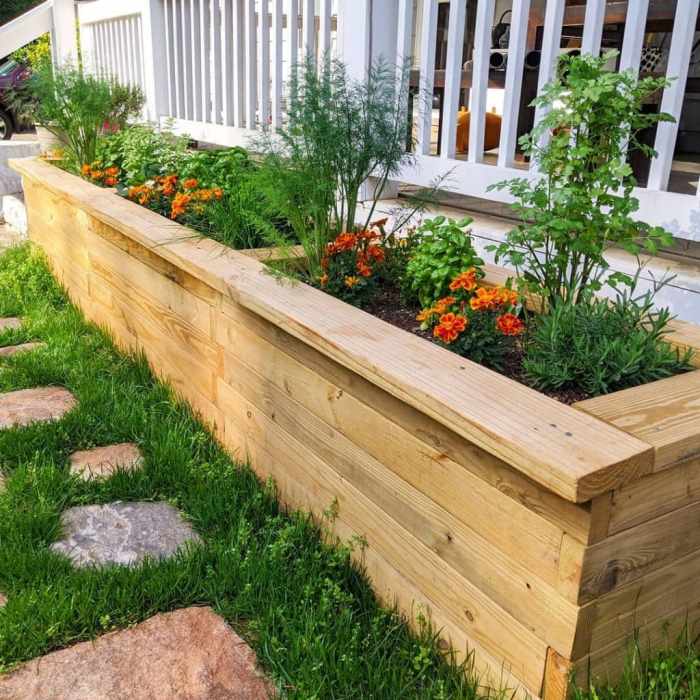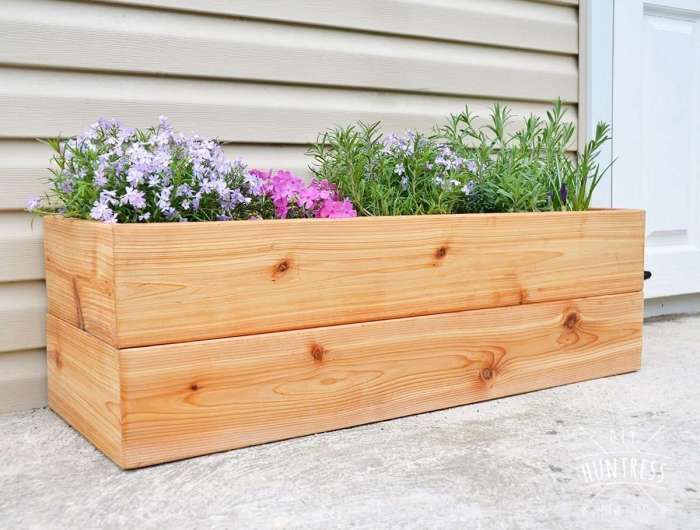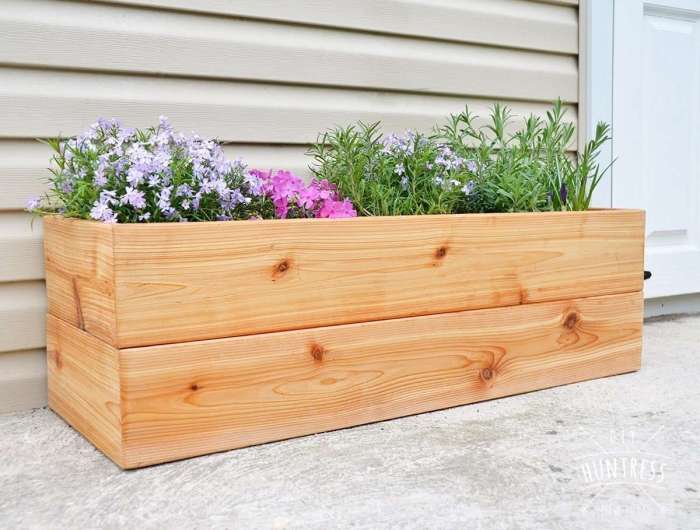DIY planter box ideas offer a fantastic way to bring your gardening dreams to life, transforming any space into a flourishing green oasis. Whether you’re a seasoned gardener or just starting out, building your own planter boxes allows for endless creativity and customization, letting you create a truly unique and personalized garden. From selecting the perfect materials to crafting unique designs, the possibilities are as boundless as your imagination.
This comprehensive guide will explore the diverse world of DIY planter boxes, covering everything from choosing the right materials and designing your dream planter to adding finishing touches and incorporating your creations into your existing landscape. We’ll also delve into upcycled planter box ideas, transforming everyday objects into beautiful and functional garden features. Whether you’re looking to cultivate a vibrant herb garden, a stunning flower display, or a bountiful vegetable patch, DIY planter boxes provide the perfect solution.
Materials for DIY Planter Boxes: Diy Planter Box Ideas

Building a planter box is a fun and rewarding DIY project, and the first step is choosing the right materials. The material you select will influence the look, durability, and cost of your planter box. Let’s explore some of the most popular options.
Wood
Wood is a classic and versatile material for planter boxes, offering a natural look and good durability. Here are some popular wood types:
* Cedar: Known for its natural resistance to rot and insects, cedar is a good choice for outdoor planter boxes. It has a warm reddish-brown color and a pleasant aroma.
* Redwood: Similar to cedar, redwood is naturally resistant to decay and insects. It has a rich reddish-brown color and a distinctive grain pattern.
* Pine: Pine is a more affordable option than cedar or redwood, but it’s not as resistant to rot or insects. It’s best suited for indoor planter boxes or those that will be treated with a sealant.
* Pressure-Treated Wood: This type of wood is treated with chemicals to prevent rot and insect damage. It’s a good choice for outdoor planter boxes that will be exposed to moisture.
Pro Tip: When choosing wood for your planter box, make sure it’s free of knots and cracks, which can weaken the structure.
Metal
Metal planter boxes offer a modern and sleek look. They are durable and weather-resistant, making them suitable for both indoor and outdoor use. Here are some common metal options:
* Galvanized Steel: Galvanized steel is coated with zinc to prevent rust and corrosion. It’s a strong and durable option, but it can be prone to dents.
* Aluminum: Aluminum is lightweight and rust-resistant. It’s a good choice for large planter boxes, as it’s easy to work with.
* Copper: Copper is a beautiful and durable material, but it can be expensive. It develops a patina over time, which adds to its character.
Pro Tip: Metal planter boxes can get very hot in direct sunlight, so it’s important to choose a material that will not damage your plants.
Plastic
Plastic is a budget-friendly and lightweight option for planter boxes. It’s easy to clean and maintain, but it may not be as durable as other materials.
* Recycled Plastic: This option is environmentally friendly and can be just as durable as traditional plastic. Look for planters made from recycled materials to reduce your environmental impact.
* Polypropylene: Polypropylene is a strong and durable plastic that is often used for outdoor planters. It’s resistant to UV rays and can withstand extreme temperatures.
* PVC: PVC is a lightweight and affordable plastic that is often used for indoor planters. It’s easy to clean and maintain, but it may not be as durable as other materials.
Pro Tip: Plastic planter boxes are often available in a variety of colors and styles, so you can find one that complements your decor.
Recycled Materials
Giving new life to old materials is a great way to create unique and eco-friendly planter boxes. Here are some ideas:
* Crates: Wooden crates can be easily repurposed into planter boxes.
* Buckets: Metal or plastic buckets can be used as planters.
* Tires: Old tires can be stacked and filled with soil to create a unique planter.
* Pallets: Pallets can be disassembled and used to build planter boxes.
Pro Tip: Get creative and use your imagination! You can find all sorts of materials that can be used to create planter boxes.
Building a Basic Planter Box
Building a simple planter box is a rewarding project that allows you to create a beautiful and functional space for your plants. This guide will walk you through the process of building a basic rectangular planter box using wood.
Choosing and Cutting Wood
The type of wood you choose will depend on your budget and the style you are going for. Common options include cedar, redwood, and pine. These woods are naturally resistant to rot and decay, making them ideal for outdoor use.
- Measure the dimensions of your desired planter box and cut the wood to size. You will need four pieces for the sides and two pieces for the bottom.
- Use a saw, such as a circular saw or a jigsaw, to cut the wood accurately. Ensure the cuts are clean and straight for a professional-looking finish.
- Use a measuring tape and pencil to mark the wood before cutting to ensure accurate dimensions.
Assembling the Box, Diy planter box ideas
Once the wood is cut, you can start assembling the planter box.
- Align the sides of the planter box and secure them together using wood glue and screws.
- Apply wood glue to the edges of the sides and then attach them to the bottom piece of wood.
- Use screws to reinforce the joints and ensure a strong and sturdy construction.
- Use a drill to pre-drill holes before inserting the screws to prevent the wood from splitting.
Adding Drainage Holes
Drainage holes are essential for preventing waterlogging and promoting healthy plant growth.
- Drill several drainage holes in the bottom of the planter box using a drill bit slightly larger than the desired hole size.
- The number and size of drainage holes will depend on the size of the planter box.
- Ensure the holes are evenly distributed across the bottom of the box.
Finishing Touches
After assembling the planter box, you can add finishing touches to enhance its appearance and durability.
- Sand the exterior of the planter box to smooth out any rough edges and create a uniform surface.
- Apply a sealant or stain to protect the wood from moisture and UV damage.
- Choose a sealant or stain that complements the style and color of your garden.
Adding Drainage and Ventilation

Creating a thriving garden in a planter box requires more than just soil and plants. Proper drainage and ventilation are crucial for healthy plant growth. Without them, your soil can become waterlogged, leading to root rot and other problems.
Drainage
Drainage is essential to prevent excess water from accumulating in the planter box. This excess water can suffocate roots, leading to fungal diseases and plant death. There are several methods for adding drainage to your planter box:
- Drainage Holes: The most common method is to drill drainage holes in the bottom of the planter box. These holes allow excess water to escape, preventing waterlogging. The size and number of holes will depend on the size and material of your planter box. As a general rule, aim for a hole every 12 inches. You can use a drill bit that’s slightly larger than the diameter of the drainage holes you want to create.
- Gravel Layer: A layer of gravel at the bottom of the planter box can also improve drainage. The gravel acts as a barrier, allowing water to drain through the holes while preventing soil from clogging them. Use a layer of gravel that’s at least 2 inches deep.
- Drainage Fabric: Drainage fabric is a permeable material that allows water to pass through while preventing soil from washing out. Place a layer of drainage fabric at the bottom of the planter box, before adding the gravel layer. This helps to keep the soil in place and prevents the gravel from mixing with the soil.
Ventilation
Ventilation is crucial for healthy plant growth. It allows air to circulate through the soil, which helps to prevent waterlogging and provides oxygen to roots.
- Choosing the Right Material: The material of your planter box can affect ventilation. Planter boxes made of wood or plastic generally provide better ventilation than those made of metal or concrete. These materials can trap heat and moisture, leading to poor ventilation.
- Planting Depth: When planting, leave some space between the top of the soil and the rim of the planter box. This allows for air circulation and prevents the soil from becoming too compacted.
- Mulching: Adding a layer of mulch to the top of the soil can help to improve ventilation. Mulch helps to regulate soil temperature and moisture, creating a more hospitable environment for plants.
With a little creativity and effort, you can easily transform your outdoor space into a thriving garden haven with DIY planter boxes. Whether you choose to build a simple wooden box, repurpose an old barrel, or experiment with vertical gardening techniques, the possibilities are endless. Embrace the joy of creating, experiment with different designs, and enjoy the satisfaction of nurturing your plants in your own personalized green oasis.
DIY planter boxes offer a fun and creative way to add greenery to your space. If you’re looking for inspiration, consider the iconic Pac-Man! A DIY Pac-Man costume, like the one featured on this website , could be a great source of inspiration for your planter box design. You can even create a mini-maze with your planters, mimicking the classic Pac-Man game!

